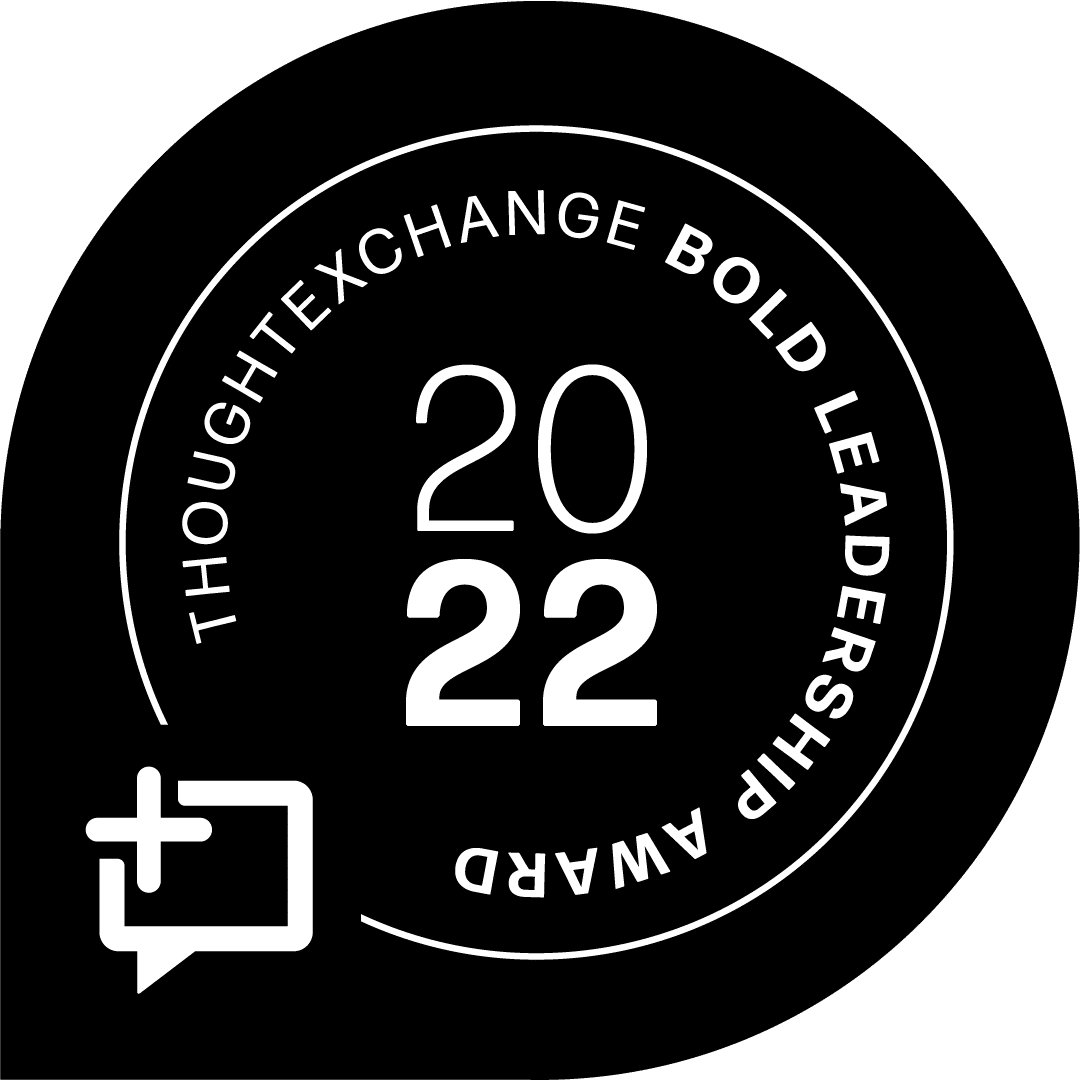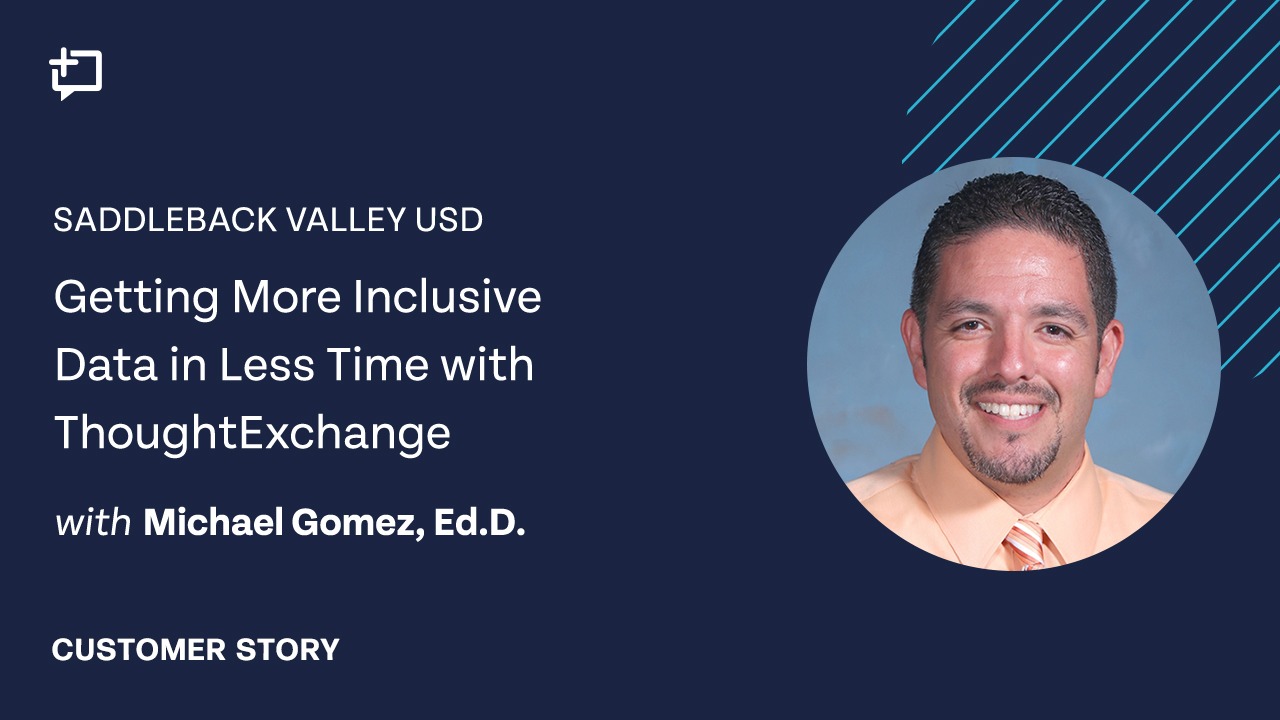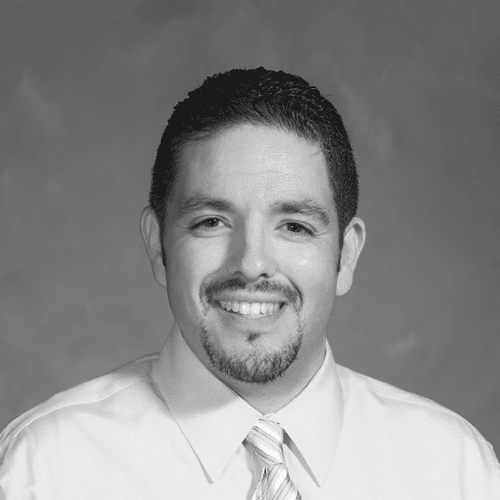Saddleback Valley Gets More Inclusive Data in Less Time with ThoughtExchange


More Feedback in Less Time
"Prior to ThoughtExchange, when we would do community surveys, we had someone who would spend almost two months processing, analyzing, and charting the data. When we brought on ThoughtExchange, she came to me and said, 'I think there's something wrong—I need all of the paperwork otherwise I’ll be behind on our LCAP. I must have missed something.' No, you didn't miss anything—the Exchange takes care of that for us now!"
Running Exchanges with their community groups gives SVUSD clear and concise areas of focus for their LCAP process. Gomez shares that it’s easy to prioritize initiatives and funding based on the results, and to work with smaller focus groups to refine the feedback even further.
With his background in qualitative research, Gomez is amazed at the speed with which an Exchange captures a wide variety of perspectives and the analysis tools that make it simple to uncover subtle data that may otherwise be missed. “ThoughtExchange takes the heart and soul of qualitative research—the data analysis and theming process—and drastically reduces the time that's spent on it,” he tells us. “We've saved weeks and weeks of work just because we had this platform.”
Uncovering Quality Data, Faster
So what’s Gomez’s expert opinion of our in-product analytic tools and supports? “They’re worth their weight in gold.”
Consulting hundreds, even thousands of people means hundreds or thousands of responses to sort through and make sense of. Gomez appreciates how simple it is to categorize the SVUSD community’s thoughts into action items using the Themes tool. “I can collapse and expand on categories in just a click,” he explains. “I’m able to go through the thoughts quickly, or I can spend more time delving into the nuance, depending on the conversation.”
Gomez also values the ability to create multiple theme sets to lean into the different angles of the conversation. One Exchange can contain valuable insights into topics like student success, facilities, or budget, and each one can be made into a custom report with its own theme set. Depending on what information he’s looking for, he can create multiple reports that highlight the topic clusters in word clouds, heat maps, and bar charts.
But he’s also grateful we don’t just sleep on our data laurels. “We get a notification of a new ThoughtExchange release, and it’s like you’ve read my mind,” he tells us. “You’re always saving me more time, or giving me the ability to take the analysis even deeper, or providing ideas I hadn’t thought of.” He likes to experiment in our Labs to see how many perspectives he can get on his data, using features like our Theme Flow Maps.
The impact ThoughtExchange has on a group discussion is felt before any data starts flowing into the product. Participants know that everything they share in an Exchange is anonymous, allowing them the space to be honest in their responses. Gomez sees a difference in how people respond when he compares it to their traditional feedback methods: “When we guarantee the process of giving confidential feedback using ThoughtExchange, people are much more open than they would have been using a survey or Google form. There's some lingering skepticism with those methods.” Knowing that decisions are based on people’s real thoughts gives leaders peace of mind when they’re taking action on the results.
Removing the Language Barriers
Like most districts in the U.S., SVUSD’s community is made up of many different language groups, and in the past, that may have been a barrier to participation for some community members. To build with these community members, including parents and caregivers of English Learners, Gomez needed a platform that would allow all participants to share ideas with each other without a language barrier.
With their District English Learner Advisory Committee meetings moved online, ThoughtExchange was the perfect vehicle to connect community members across language groups, which included Farsi, Spanish, Korean, Japanese, and English. Gomez tells us that some attendees were worried that their perspectives wouldn’t be represented at the meeting, but the live Exchange he ran put their minds at ease. “As I was watching the live Exchange, it was amazing to see the real-time translation as people were sharing thoughts in their native tongue.”
Since connecting people is our goal, we’ve built multi-language capabilities into the product so that all participants can share and read thoughts in the language of their choice. For the districts we work with whose communities encompass many languages, this feature has been a game-changer. “Previously, we’ve looked at language as a barrier to participation,” Gomez explains, “but that was blown out of the water by using ThoughtExchange to engage different groups and educational partners in our district.”
Making an Impact on SVUSD
With community feedback being vital to the education sector, Gomez made ThoughtExchange an essential step in the district’s operations. Like many of our education leaders, he knows that running an Exchange with stakeholders translates into decisions that get the community’s support.
When it comes to SVUSD’s equity initiatives, Gomez saw a real benefit in using ThoughtExchange to connect with their schools’ leadership. While working to find effective ways to implement equity in their district operations and student supports, candid discussions with their principals has made a big difference. “Knowing that an Exchange allows for that confidential feedback, we can hear how our leadership is really feeling when it comes to our equity initiatives,” he shares. “This helps us respond with impactful changes to supports and learning.”
He also built Exchanges into their hiring process for principals. In the past, when an SVUSD principal position opened up, he hosted focus groups with teachers and parents to find out what the school wanted from its new leader. Now, as soon as a posting happens, HR uses templated Exchanges. “We run the Exchange and gather feedback from our different stakeholder groups,” he explains, “and that helps HR build a profile for hiring the next principal.” Where focus groups are dependent on the teachers and parents who have the time and motivation to join the conversation, an Exchange is easily accessible and allows for everyone to have input on the new hire, all in just a few minutes.
Another place Gomez uses ThoughtExchange is in gathering feedback from staff on their professional development programs. Instead of using a Likert scale survey—where respondents specify their level of agreement or disagreement with predefined answers—to get an idea of the value staff took from the training, an Exchange gives him a depth of data that helps SVUSD to deliver quality learning and help staff put it into practice in the classroom. “We can get a good idea of what our staff’s takeaways are and also the supports they need to implement the training,” he tells us.
Before ThoughtExchange/After ThoughtExchange
As far as how ThoughtExchange has impacted SVUSD, Gomez explains it to us in terms of a “before and after,” and according to him, “there's absolutely no comparison prior to using ThoughtExchange.” Did we mention Gomez is a ThoughtExchange champion? We’ll let him tell you:
“I constantly sing the praises of ThoughtExchange to my colleagues. You truly don't know the benefits until you jump in. Once you experience how it reduces your processes, timing, and workload—you'll never go back. It's never a question of, do we continue ThoughtExchange next year? It's, how are we going to use it differently, and how can we innovate from there?”


Gain clarity, not clutter.
Turn insights into action today.
